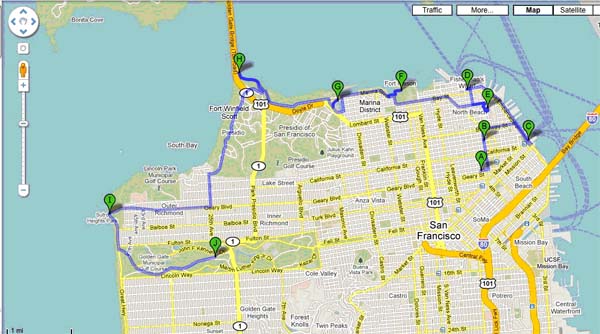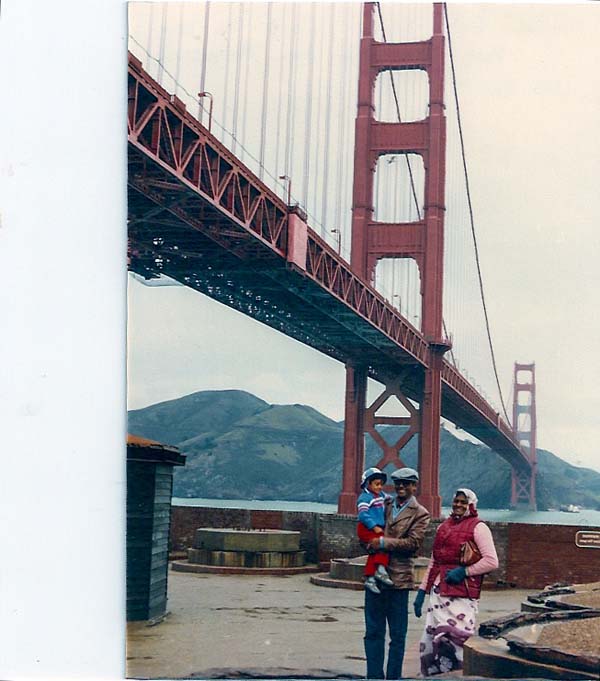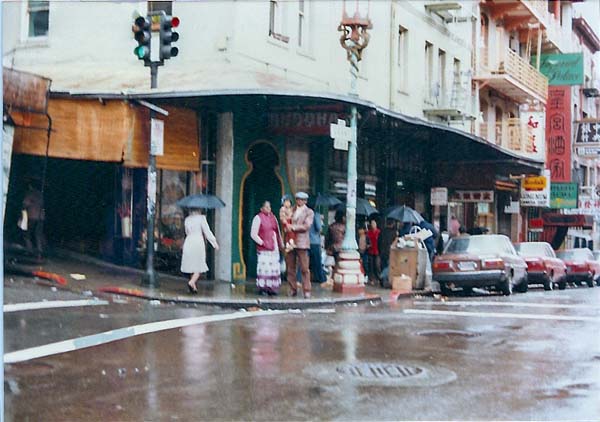The Travels of a Journalistâ€â€ÂÂ25 (Part B)-CALIFORNIA EXPLOITS: UNCOVERING SAN FRANCISCO WITH FAMILY
Posted on May 4th, 2010
By Shelton A. Gunaratne ƒÆ’-¡ƒ”š‚©2010
Uncovering Golden Gate
Despite rainy weather, we spent most of Day 3 (Friday) at the 1,017-acre rectangular-shaped (0.5 miles x 3 miles) Golden Gate Park, located about four miles south of the Golden Gate Bridge, a suspension bridge spanning the Golden Gate, the opening of the San Francisco Bay into the Pacific Ocean. We had already crossed this bridge on our camping trip to Mount Tamalpais in August. Built in1937, it has been ranked fifth on the List of America’s Favorite Architecture by the American Institute of Architects.
However, our focus on this occasion was the park, not the bridge. We visited the parkƒÆ’‚¢ƒ¢-¡‚¬ƒ¢-¾‚¢s main features: Conservatory of Flowers, a glass building erected in 1879 a la Kew Gardens. (Since our visit, a severe storm shattered its glass structure in 1995.ƒÆ’-¡ƒ”š‚ It was reopened in 2003.); Kezar Stadium, equipped with 59,000 seats, that hosted many athletic events (but since our visit, the original stadium was demolished in 1989 and replaced with a modern 9,044-seat facility.); and San Francisco Botanical Garden at Strybing Arboretum, where we went on an exploratory tour through the 55-acre expanse of special collectionsƒÆ’‚¢ƒ¢-¡‚¬ƒ¢¢”š¬‚Demonstration Gardens, Biblical Garden, Garden of Fragrance, Zellerbach Garden of Perennials, Moon-viewing Garden, Succulent Garden, Redwood Trail, Garden of California Native Plants, Conifer Garden, and so on.
For us, the primary attraction of the park was the Music Concourse Area, particularly the California Academy of SciencesƒÆ’‚¢ƒ¢-¡‚¬ƒ¢¢”š¬‚one of the 10 largest museums of natural history in the worldƒÆ’‚¢ƒ¢-¡‚¬ƒ¢¢”š¬‚where we spent much of our time studying the exhibits in Wattis Hall of Man, Steinhart Aquarium, Fish Roundabout, North American Bird and Mammal halls, Fossil Hall, Mineral Hall, Simson African Hall, Science Hall and Lovell White Hall.ƒÆ’-¡ƒ”š‚ (In 2010, general admission to CAS was $25 with discounts for seniors, students and children.) We donƒÆ’‚¢ƒ¢-¡‚¬ƒ¢-¾‚¢t know to what extent Junius benefitted from these exhibits. But we certainly know that he enjoyed the visit to the nearby childrenƒÆ’‚¢ƒ¢-¡‚¬ƒ¢-¾‚¢s playground.
Since our visit, the park has added another main attraction: the AIDS Memorial Grove, established in 1996. Other attractions included Stow Lake, Spreckels Lake, Golden Gate Park Stadium, Bison Paddock, Windmills, Beach Chalet and Roadways.
We left the academy at 3 p.m. and drove around the entire park although it was raining cats and dogs. At the western edge of the park, we turned north on Point Lobos Avenue to enter Sutro Heights Park, where we visited Cliff House to watch Seal Rocks to the west and Sutro Baths to the north.
Sutro Baths were a privately owned swimming pool complex opened to the public in 1896 by entrepreneur Adolph Sutro, who was mayor of San Francisco from 1894 to 1896. He also built a seven-story Victorian chateau (nicknamed ƒÆ’‚¢ƒ¢-¡‚¬ƒ…-The Gingerbread PalaceƒÆ’‚¢ƒ¢-¡‚¬ƒ”š‚) on the cliffs next to the baths. But these material representations of tanha (desire/craving) could not defy the truths of anicca (impermanence) and dukkha (unsatisfactoriness). A fire destroyed the baths and the palace in September 1907. The rebuilt baths faced the same fate again in 1966. Only the ruins of the baths remain.
North of the baths, we drove to see the USS San Francisco Memorial at LandƒÆ’‚¢ƒ¢-¡‚¬ƒ¢-¾‚¢s End. Then, we stopped at the nearby Palace of the Legion of Honor in Lincoln Park for a quick look at the exhibits.ƒÆ’-¡ƒ”š‚ Thereafter, we crossed San Francisco from west to east along Lincoln Boulevard and Lombard Street to see the ƒÆ’‚¢ƒ¢-¡‚¬ƒ…-Crookedest [most winding] Street in the WorldƒÆ’‚¢ƒ¢-¡‚¬ƒ”š‚ƒÆ’‚¢ƒ¢-¡‚¬ƒ¢¢”š¬‚the one-way section of Lombard Street on Russian Hill between Hyde and Leavenworth streets. Here, the roadway has eight sharp turns (or switchbacks) instituted in 1922 to reduce the hill’s natural 27 percent grade, which was too steep for most vehicles to climb. The speed limit in this section is 5 mph (8ƒÆ’-¡ƒ”š‚ km/h).
Next, we stopped in Chinatown, just to the northeast of our hotel, to purchase our dinner. San FranciscoƒÆ’‚¢ƒ¢-¡‚¬ƒ¢-¾‚¢s Chinatown is the oldest Chinatown in North America. Established in the 1840s, it became the starting point and home for thousands of Chinese immigrants. Its shops, restaurants and attractions draw more tourists annually to San Francisco than the Golden Gate Bridge. On Day 1 (Wednesday), during our (restricted to Yoke-Sim and me)
self-guiding walking tour of San Francisco, we had already ambled along Grant Street to see the heart of Chinatown and visited the Chinese Culture Center and the Chinese Historical Society of America.
From Chinatown, all of us drove to Nob Hill to visit the free Cable Car Museum (1201 Mason St.) because San Francisco is synonymous with its cable cars. Cable cars are not the same as San Francisco’s trolleys, which operate on Market Street. The San Francisco cable car system is the world’s last permanently operational manually operated cable car systemƒÆ’‚¢ƒ¢-¡‚¬ƒ¢¢”š¬‚a transport network operated by the San Francisco Municipal Railway. Cable cars operate on two routes from downtown near Union Square to Fisherman’s Wharf, and a third route along California Street. Although my mother recalled the tramcars and trolley buses that cluttered the streets of Colombo in the 1950s, she did not wish to ride a cable car in San Francisco because of the high fares.
Uncovering North side
Day 4 (Saturday) was another rainy day. Undeterred, all of us set forth to explore the north shore of San Francisco.ƒÆ’-¡ƒ”š‚ Because no visit to San Francisco would be complete without seeing the Embarcadero, FishermanƒÆ’‚¢ƒ¢-¡‚¬ƒ¢-¾‚¢s Wharf and Alcatraz, we revisited the locations to provide a sense of these features to mother and Junius missed them on Day 1. Then, we moved on to Fort Mason, since 1976 a part of the Golden Gate National Recreation Area, and walked down to see the former barracks transformed into a regional cultural center. From here, we had an outer view of the Jeremiah OƒÆ’‚¢ƒ¢-¡‚¬ƒ¢-¾‚¢Brian berthed at Pier 3.
Moving on Marine Drive, our next stop was the Palace of Fine Arts (3301 Lyon St.), the only remnant of the 1915 Panama-Pacific Exhibition. Here, we were pleased to find the delights of the Exploratorium (current general admission $14 with various discounts), a science museum with more than 500 (>1,000 in 2010) interactive exhibits. I was most interested in the exhibits on language development. Both mother and Junius enjoyed the machines, the lights and the sounds. We spent two hours in the facility, set up in 1969 at the behest of physicist Frank Oppenheimer.
Our next stop was the Presidio Army Museum housed in the Old Station Hospital, built in 1859. From there, we went to see the Fort Point National Historic Site, a granite fortification built in 1861 under the southern end of Golden Gate Bridge, along the lines of Fort Sumter. We climbed up to the top of the fort to have a very close view of the famous bridge, as well as of Alcatraz. This proved to be an unexpectedly interesting site/sight.
We left the Presidio to see Temple Emanu-el (2 Lake St.), a synagogue, built in 1925 with a 150-ft. orange-hued dome. Our last stop was Chinatown, where we bought our dinner and a few gifts.
Grand Hurrah
Our tour of San Francisco came to an end on Day 5 (Christmas Sunday). We checked out of Adelaide Inn, which turned out to be an inexpensive lodge right in the heart of downtown. We spent the morning in Chinatown. I showed my family the location of Buddha Lounge (901 Grant St.) about which I created a ha-ho in Sri Lanka in 1966-67 because the association of Buddha with an alcoholic establishment is nothing short of sacrilege. Maybe the Rajapakse Government should take up the matter directly with San Francisco Chinatown.
We left Chinatown about 11 a.m. Overcast skies and continuing rain chased us as we drove south. We stopped in Salinas for lunch and arrived in Santa Barbara about 7 p.m. We ate a buffet dinner at the Holiday Inn in Goleta, where Don Voegele, a colleague of mine at Fullerton College, directed us to his brotherƒÆ’‚¢ƒ¢-¡‚¬ƒ¢-¾‚¢s studio apartment (at 590 Ribera St., Goleta) to settle down for the night.
The next morning, Voegele gave us a brief tour of Santa Barbara, primarily for motherƒÆ’‚¢ƒ¢-¡‚¬ƒ¢-¾‚¢s benefit. We left Santa Barbara for Los Angeles about 1.p.m. To make mother happy, we took her to the Buddhist Vihara (1147 N. Beachwood Drive) in Los Angeles. The priests, Ahangama Dhammarama Thera and D. Gnanissara Thera welcomed us and administered Pansil.ƒÆ’-¡ƒ”š‚ At the temple, I was delighted to have a conversation with Sri Lankan journalist Walter Jayawardhana.
We were back in Fullerton that evening.
ƒÆ’-¡ƒ”š‚ Next: A Taste of San Diego: Say Hello to Wild Animals and Nudists
(The writer is a professor of mass communications emeritus, Minnesota State University Moorhead.)
Figure 1: Main Attractions in San Francisco: A=Union Square; B=Chinatown (Buddha Lounge); C=Embarcadero (Ferry Building); D=Fisherman’s Wharf; E=Coit Tower (Telegraph Hill); F=Fort Mason; G=Exploratorium; H=Fort Point National Historic Center (underneath the south-end of Golden Gate Bridge); I=Seal Rocks and Sutro Baths; J=Golden Gate Park. Alcatraz (not in the map) is visible from the north shore.
Picture 1: WeƒÆ’‚¢ƒ¢-¡‚¬ƒ¢¢”š¬‚including the author, his mother and son Junius (pictured)ƒÆ’‚¢ƒ¢-¡‚¬ƒ¢¢”š¬‚climbed up to the top of Fort Point National Historic Site (24 Dec. 1983) to have a very close view of the Golden Gate Bridge, as well as of Alcatraz. This proved to be an unexpectedly interesting site/sight.
Picture 2: The author (with his mother and son) in front of Buddha Lounge at 901 Grant St. in San FranciscoƒÆ’‚¢ƒ¢-¡‚¬ƒ¢-¾‚¢s Chinatown (25 Dec. 1983). He asserts that the association of Buddha with an alcoholic establishment is nothing short of sacrilege.



May 5th, 2010 at 1:03 pm
great site really informative i learned a lot great stuff keep it up
by anna casinos en ligne
May 6th, 2010 at 7:57 am
I request Sita to let me know which specifics in this travelogue appear to be not genuine. I do use other authoritative sources to supplement my diary entries.